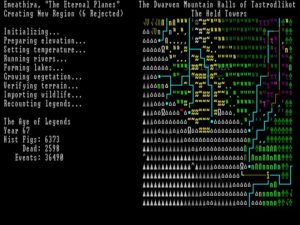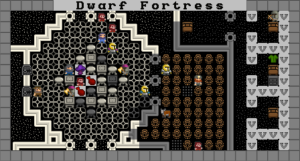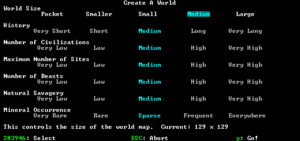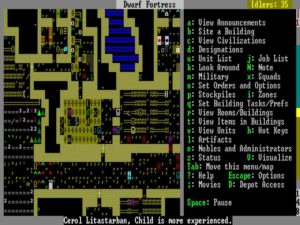- Graphics/Visual Effects 1
- Story Content 10
- Story Pacing 7
- Gameplay 8
- User Interface/Controls 1
- Soundtrack 5
- Replayability 10
- Completeness 3
- Support 8
- Uniqueness 10
Check out my latest Let’s Play series of Dwarf Fortress with my wife here:

As I have recently not had the funds to buy a lot of new games, I have been interested in trying various free and older, low cost games. After stumbling across a recommendation for it on Reddit, I looked into Dwarf Fortress, Tarn Adam’s “roguelike” (refers to games similar to the game Rogue http://en.wikipedia.org/wiki/Rogue_(video_game)) dwarf civilization simulator. What interested me at first was someone’s observation that the worlds one creates in the game take on a life of their own. For example, I might be running a dwarf fortress that is eventually conquered by goblins. I could continue playing the game as other civilizations or as adventurers and one day come back to my abandoned fortress–the game will remember it and allow you to revisit it or even reclaim it by sending another dwarven expedition. This persistence in the world intrigued me and struck me as an effective way to make a game feel like it has a deep, mythical past.
I did not know whether I would write a review on Dwarf Fortress for this blog primarily because I know that it will be scored poorly on my rubric, primarily because its graphics and interface are extremely obscure, difficult to learn, and frankly look very dated despite the game being first released in 2006. And therein lies another difficulty, as the game is technically still an alpha with Tarn Adams claiming that he expects it to take 20 years to complete. Therefore, any review I offer now could be superseded by the next release and be completely irrelevant; however, the fact remains that the game is fairly popular even as an alpha, which means that as far as I am concerned we are dealing with a completed game (any updates released should be, in my view, considered additional releases because of the extremely long schedule of development for this game).
Therefore, I will be evaluating the most recent version of the game as if it were a standalone title. What I have to say may not apply to older or newer versions. Additionally, I will give the game a rating according to my rubric but will explain in my final paragraph why the low score the game receives may not matter to most people who would be interested in this game. So, although the game only gets a 68 from my scale, it may be one of the best games for you if you are a particular type of player.
The graphics for this game are based on ASCII characters or, if the player downloads additional mods by other players, simple tile sets. Each character has a pre-defined meaning in the game, for example some will refer to water, some to grass, some to trees; this system requires a lot of getting used to and I spent a good deal of my first few fortresses’ playtime simply looking at information on various tiles. I admit to using a tile set to ease my starting of the game, as in my view these tile sets made things look a lot more like what they are supposed to look like (I will link to my favorite tile set at the end of this review). The ASCII version is so difficult to understand at first with no visual cues as to what is what that I would imagine almost any player will be completely confused about what they are looking at when starting the game.
 |
| The ASCII graphics of the base game make Dwarf Fortress unappealing to many mainstream gamers. |
 |
| A tileset makes the game a bit more palatable in my opinion, though many experienced players prefer ASCII because it identifies objects more specifically once you learn how it works. |
As the game was released in the same year as the Elder Scrolls IV: Oblivion, there is no way I can give it a score any higher than 1 because in terms of graphics the game is twenty years behind its time.
The stories inherent to Dwarf Fortress are, like Crusader Kings 2 that I have reviewed in the past, generated by playing the game itself. This story-creating potential is one of the aspects of games that I truly enjoy; I am not necessarily playing through a scripted story that a writer somewhere has drafted but am participating in the unfolding story of the game itself. Even though the way these stories unfold is scripted into the game, it does not feel formulaic in most cases, giving the sense that the game has become a storytelling entity of its own.
When you first begin playing Dwarf Fortress, you must generate a world for your dwarves to live in. You select various parameters such as how savage the wilderness is and how many evil masterminds exist, and then the game constructs a world, complete with continents, oceans, islands, cities, and all sorts of landscapes. The sheer depth of this world generation is staggering to me, as there will be various cities that will live, die out, and become ruins even as others are being constructed. Likewise, various landscapes have a wide variety of climates and animal populations that will directly impact your fortress once you begin playing. This depth even goes below the surface, as some areas will have underground aquifers and some will not, and various types of rock and ore are located in what I am told are very geological correct patterns.
 |
| This screen shows the various options for world characteristics. Changes here will have profound impact on the game. |
After the world is created, then time begins to move forward; the game simulates hundreds of years of history including conflict between human, elf, and dwarf civilizations and the movements of huge monsters and goblin tribes. After completing this history, the player has the option of entering the “legends” mode, which lists the historical events and figures that have influenced the world during world creation (or afterward if you’ve already played some). The detail here is incredible, and the way these worlds are created and populated with a past is something I have yet to see in any other game out there.
The player’s participation in the world of Dwarf Fortress largely occurs under the surface, as your small backwater fortress can become, after building up significant wealth, a major city of a dwarf kingdom, even eventually becoming a capital. As the capital, your fortress has significant influence over the events passively occurring throughout the world you have generated. Even after abandoning a fortress, you can find information about it in the legends mode of the game, demonstrating how your actions as a player have lasting impact on the world you created.
The individual dwarves even have incredibly detailed stories. You can select one and read their description and here all about their characteristics, families, talents, and life events. These characteristics are persistent across many playthroughs, meaning that it is conceivable that you will meet a dwarf in adventure mode who is a relative of one you’ve used in fortress mode. The way the game keeps track of these intersecting life stories is just mindboggling to me.
Because of its depth, personal touch, and story generating potential, I can give Dwarf Fortress a 10 for story content. If you do not agree with my assessment, then check out some of the AARs (after action reports) people have written about their Dwarf Fortress experiences. Here are a few links to get you started:
http://www.dfstories.com (a great site for finding various stories people submit)
http://lparchive.org/Dwarf-Fortress-Boatmurdered/ (one of the most legendary Dwarf Fortress stories)
This is a difficult category to judge for this game, as the gameplay is the story. The story progresses as quickly as the player plays. However, certain elements of the game might be considered paced story events–such as the arrival of migrants to your fortress or goblin invasions. These events occur at somewhat regular intervals–as in, you will not receive a goblin invasion before a certain population count (I believe it is roughly 80 population). There are also tiered ways of viewing your fortress’s progression through the arrival of nobles and the accumulation of wealth. These measurements roughly give you the idea of what part of the story of your dwarf fortress you are at.
The pacing is at first incredibly intense. The first fortress I built was faced with goblin invasions before I felt like I had time to build a military; this is a fairly common experience for most new players. However, once you learn the pace of these types of events, you can prepare for them. In my second fortress, I had a much better defense set up that easily took out the first goblin invasions. So the feel of the story pace is dependent on player experience; for new players it will be too fast, while experienced players might find it too slow to be challenging. For this reason, I give the game a mid-range rating of 7 for story pacing.
Gameplay in Dwarf Fortress is divided into two modes (there is also a Legacy mode, but this is just a browser to review the stories in your created world): fortress mode and adventure mode. These modes offer very different experiences but are tied together through the persistent world you create when you first launch the game. Everything that is done in one mode will be a part of the world and might affect gameplay in the other mode. For example, adventurers can return to abandoned fortresses the player built in fortress mode to find treasure and fight monsters that now infest it.
Fortress mode is the namesake of the game, and it allows you to pick any site in your entire world to embark with 7 pioneer dwarfs to establish a new settlement. Every single thing about a site will probably affect how you build your fortress; for example, clay soil will allow you to make various ceramic crafts and a river will provide your dwarves with an easy source of water. When preparing to start a new fortress, players can specify what types of skills the 7 dwarves will have (anything from mining to metalworking to weaving) and what items they will bring with them (anything from buckets to animals to weapons). The choice of what items and skills to bring depends on your personal preference, but certain skills are essential to success (such as mining and farming). The ability to choose effective expeditions comes with experience, as many different options will be completely useless to start a fortress.
From that point, the player can do anything he or she wants in their expedition site; most will choose to dig down into the earth through mining and carve out various chambers for the dwarves’ bedrooms, stockpiles, and workshops. This openness really makes the gameplay intriguing. What is most exciting to me is discovering what types of metal ores are present at your site (you don’t know what types there are when you embark, only that there are some metals there) and then deciding how you will build furniture, weapons, traps, etc. with the resources you have.
As the fortress grows, players will want to establish trade depots, at least a minimal military, and a lot of traps to stop any invasions. Aside from these basic needs, the sky is the limit. Many players pride themselves on creating grand fortresses out of glass or gold, while others like the feel of a heavily industrial fortress that produces a ton of goods. As you progress, you will even have the option of creating structures above ground.
Adventure mode is slightly less open-ended because generally you start out in a small village and receive various quests to defeat bandits and other enemies. You can hire people to be your companions (something you must do because even a highly trained starting character will die easily on his or her own) and build up your wealth and fame through fighting ever more powerful enemies. The problem with this mode is that it seems even more difficult than fortress mode–if that is possible. I found myself dying constantly even with a demi-god character (which gives you a lot more points to spend on starting skills and stats).
I think overall, therefore, the gameplay is open-ended and innovative, but it is extremely difficult even for experienced players. This difficulty is good in some respects, but it makes the gameplay less interesting to the mainstream gamer. With this critique in mind, I think a rating of 8 for gameplay is fair.
UI and controls for Dwarf Fortress are probably its greatest weakness. While many players might be able to overlook a lack of graphics, as many gamers don’t care about graphics at all, a poor UI can ruin anyone’s experience with the game. Dwarf Fortress’s interface is incredibly complex, probably using every key on the keyboard for some purpose or another. This is not a terribly bad thing except that there are also lists everywhere for everything, and the way to scroll through them is frustratingly inconsistent. At times, you use the arrow keys to scroll, but other times you (surprisingly) use the + and – keys or the / and * keys for the same purpose. When you use each method is often difficult to know, and I am usually quite frustrated when I need to navigate through lists and have to try each method before I find the right one.
 |
| As you can see from the menu at the right, this game has an incredibly complex UI menu system. |
Because of the UI issues of this game, new players NEED to read internet tutorials; otherwise, they will not know where the mining option is, for instance, or what the difference between the “Designation” staircases and the “Construction” staircases is. These layers of different types of tasks make the UI extremely hard to learn, and I strongly advise anyone who wishes to play the game to spend time reading about the UI before trying to play the game. You can save yourself a lot of frustration.
Here are a few useful links for learning the interface and controls:
The soundtrack of this game is mostly a pleasant acoustic guitar background that gives the game a real feel of “living on the frontier” in your fortress. The feeling is similar to the Oregon Trail to me, as I feel like my dwarves are pioneers sitting around a campfire. The soundtrack, then, gives the game a great environment; however, perhaps because of the nature of the gameplay, the soundtrack feels very repetitive. I honestly play with no sound most of the time now because, although I like the environment, there just isn’t enough variety to keep sound enabled for the sheer number of hours a player can play this game.
Replayability is one of the strongest categories for this game; in fact, the entire concept of the game requires that the player play many times in several different forts. This is the point of the persistent world, so that there is a pay off to even failed fortresses/adventurers because they have a lasting effect on the world. Part of the fun (not “fun”) of the game is to rediscover these past experiences later. Not only the persistent world encourages replay, but the sheer difficulty of the game makes several playthroughs essential. Everyone who plays the game will be losing, a lot; and the gamer who truly desires to win (or to be successful for a relatively long period of time, Dwarf Fortress’s equivalent of “winning”) will be learning from losses and will want to play again with new circumstances, strategies, etc. Furthermore, even the world itself encourages replay because if you get bored with the entire world of your Dwarf Fortress, you can simply recreate it for a whole new experience from the ground up.
It would be somewhat disingenuous to give Dwarf Fortress a good rating in this category because, regardless of how it functions as a working game, it is still an alpha. Some features are undeveloped, such as how worlds only die, they rarely if ever create new historical figures/towns after world development. This means your world will expire after a certain number of years. There are also plans to develop multiracial settlements and ways to expand your fortress into a kind of empire by conquering bandits, necromancers, etc. The game, then, is not complete and probably will not be in a long time; however, the game is at a good place of usability while still being incomplete and functions well in its more limited (compared to its creator’s vision) capacities.
There are also some bugs that make the game annoying in some points. I’ve found that there is no way to directly tell dwarves to avoid leaving the fortress during a goblin invasion (one of the tutorials showed how to do this, but I found that this process did not work), and to do so requires complicated use of “burrows,” a completely unintuitive system if you ask me. You can also put an infinite number of items in a single square designated as a garbage dump; I believe this is a bug that makes it very easy to get rid of stone debris in your fortress (stone management, as most Dwarf Fortress players call it). It just seems too easy to me to not be an exploitable bug.
There are probably other bugs, but at this point I have yet to encounter them. It is simply the nature of the product as it stands, so these things do not bother me too much about this game, but it does force me to lower this category’s rating.
The developers maintain a great relationship with their players, answering questions on forums and on the Dwarf Fortress podcasts. In addition, they send handmade gifts (a drawing or a short story) to anyone who donates to the game’s development, adding a real personal touch to the development team for any player that chooses to support the game. I think these factors make the support rating fairly high, as I can sense that they really care about the players and want to answer questions and add features that their player base wants.
Check them out: http://www.bay12games.com/dwarves/ (you can also download the game here).
Frankly, no other game matches the sheer depth, breadth, and complexity of this game. There is no other game I have found with such a complete crafting system while also allowing for military activity. I have seen no other game that allows such unorthodox strategies as constructing a magma moat or taming elephants to use as defenders. I also know of no other game that has such an interesting way of doing mining, with distinct layers and realistic formations. No other game forces me to be as inventive as Dwarf Fortress, and I simply don’t believe that it will ever be quite matched. The game is something unique that anyone with the patience to learn how to play it should experience.
Intangible: +5
Dwarf Fortress’s uniqueness is so striking to me that it affects my intangible rating for this game. I cannot think of any other game that even goes so far as to simulate every organ in every creature in the game, deciding what types of injuries happen on what organ and how this injury will affect the creature. Players can also build things out of just about anything. You can have a golden bucket or lead coins or even glass walls. Triple-A title developers simply do not have the time or drive to put this incredible depth into their games, which is why many gamers popularly hold that the idea of a “Dwarf Fortress with graphics” is an impossibility. It can even be argued that Dwarf Fortress’s lack of graphics allow it to be built with this complexity because the sheer memory load of graphics added to this already memory intensive game (memory intensive simply because of all that is going on at once at any time) would make it impossible to run on any but the most high-end machines.
This discussion leads me to say that, yes, the rating I’m giving this game is low, but I really like it and find it a valuable gaming experience unlike anything else I have experienced. I have rated it with the same rubric I use for mainstream games, and it has come up with a relatively low rating, but for the player looking for a challenge or something completely different, Dwarf Fortress is one of the best choices. I think this game pushes the boundary of what it means to be a game and will have profound influence on the future of gaming. Therefore, if you think you have the patience to learn the interface and deal with the lack of graphics, you should play this game; I guarantee that once you learn it, you will like it. However, those who only like modern games should avoid this one.
 |
| Mega Constructions are what Dwarf Fortress players call extremely elaborate layouts and buildings in the game. Above is an example of one such mega constructions rendered in the Stonesense graphical utility. |
To help you get started, I’ve compiled a few links to utilities and tutorials that I used and that will help anyone getting started:
The Lazy Newb Pack (http://www.bay12forums.com/smf/index.php?topic=59026.0)–despite its name, it is one of the most helpful utilities I’ve found. It comes bundled with a few texture packs to replace the ASCII graphics if you wish to use them and Dwarf Therapist, an essential utility for managing labor in fortress mode. It includes the game itself, so don’t bother downloading the game separately.
Dwarf Fortress Wiki (http://dwarffortresswiki.org/)–an essential website for any questions you have as you play. The most exhaustive repository of information on the game available.
Tutorial (http://dwarffortresswiki.org/index.php/DF2012:Tutorials)–a Wiki page that gives listings of useful tutorials and help for starting the game.
Mayday Tileset (http://artgoblin.pl/df.php)–this is the tileset I use. I just like it a bit better than the ones in the Lazy Newb Pack.
DFHack (http://www.bay12forums.com/smf/index.php?topic=91166.0)–allows you to hack the game. Kinda like a console screen in some pc games. It also includes Stonesense, which allows you to see what your fortress looks like in a 3d graphical representation.
Tutorial video (http://www.youtube.com/watch?v=z2mL_PFIKDY)–one of many tutorial video sets. Be careful that you are watching videos for the current version if you search for them on your own.
Final Score: 68
Please follow my blog if you like my review!
Also, I am currently freelance. Please contact me if you are a developer or website looking to hire me to review a game.

